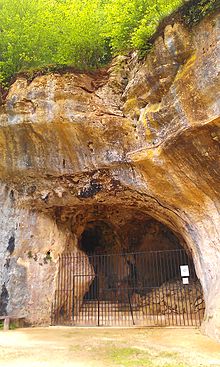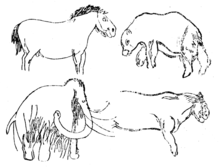
Lascaux is a network of caves near the village of Montignac, in the department of Dordogne in southwestern France. Over 600 parietal wall paintings cover the interior walls and ceilings of the cave. The paintings represent primarily large animals, typical local contemporary fauna that correspond with the fossil record of the Upper Paleolithic in the area. They are the combined effort of many generations and, with continued debate, the age of the paintings is now usually estimated at around 17,000 years. Because of the outstanding prehistoric art in the cave, Lascaux was inducted into the UNESCO World Heritage List in 1979, as an element of the Prehistoric Sites and Decorated Caves of the Vézère Valley.
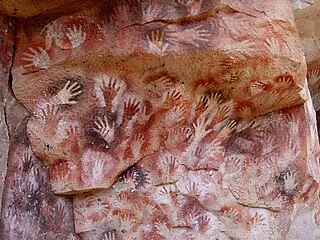
In archaeology, cave paintings are a type of parietal art, found on the wall or ceilings of caves. The term usually implies prehistoric origin, and the oldest known are more than 40,000 years old and found in the caves in the district of Maros. The oldest are often constructed from hand stencils and simple geometric shapes. More recently, in 2021, cave art of a pig found in Sulawesi, Indonesia, and dated to over 45,500 years ago, has been reported.

Cro-Magnon is an Aurignacian site, located in a rock shelter at Les Eyzies, a hamlet in the commune of Les Eyzies-de-Tayac-Sireuil, Dordogne, southwestern France.

Périgord is a natural region and former province of France, which corresponds roughly to the current Dordogne department, now forming the northern part of the administrative region of Nouvelle-Aquitaine. It is divided into four areas called the Périgord Noir (Black), named so for the truffles that can be found there, the Périgord Blanc (White), for chalk cliffs and quarries, the Périgord Vert (Green), for forests and forestry and the Périgord Pourpre (Purple), for wine and viticulture. The geography and natural resources of Périgord make it a region rich in history and wildlife, and the newly created Parc Naturel Régional Périgord-Limousin aims to conserve it as such.

Les Eyzies-de-Tayac-Sireuil is a former commune in the Dordogne department in Nouvelle-Aquitaine in southwestern France. On 1 January 2019, it was merged into the new commune Les Eyzies.

The Vézère is a 211-km-long river in southwestern France. It is an important tributary to the Dordogne. Its source is in the northwestern part of the elevated plateau known as the Massif Central. It flows into the Dordogne near Le Bugue. A tributary of the Vézère is the Corrèze.

Henri Édouard Prosper Breuil, often referred to as Abbé Breuil, was a French Catholic priest, archaeologist, anthropologist, ethnologist and geologist. He is noted for his studies of cave art in the Somme and Dordogne valleys as well as in Spain, Portugal, Italy, Ireland, China with Teilhard de Chardin, Ethiopia, British Somali Coast Protectorate, and especially Southern Africa.
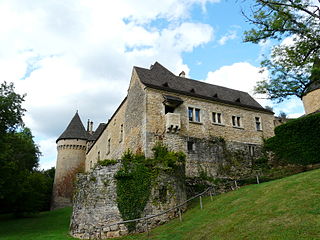
Montignac-Lascaux, is a commune in the Dordogne department, Nouvelle-Aquitaine, Southwestern France. It is a small town situated on the Vézère river and has been the capital of the canton of Montignac since 1790. In 2015 it became the capital of the newly created Canton de la Vallée de l'Homme. The poet Pierre Lachambeaudie (1806–1872) was born in the village.

Font-de-Gaume is a cave near Les Eyzies-de-Tayac-Sireuil in the Dordogne départment of south-west France. The cave contains prehistoric polychrome cave paintings and engravings dating to the Magdalenian period. Discovered in 1901, more than 200 images have been identified in Font-de-Gaume. Along with other nearby prehistoric archeological sites, Font-de-Gaume was inscribed on the UNESCO World Heritage List in 1979 as the Prehistoric Sites and Decorated Caves of the Vézère Valley.
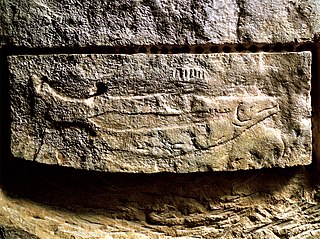
The Prehistoric Sites and Decorated Caves of the Vézère Valley is a UNESCO World Heritage Site in France since 1979. It specifically lists 15 prehistoric sites in the Vézère valley in the Dordogne department, mostly in and around Les Eyzies-de-Tayac-Sireuil, which has been called the "Capital of Prehistory". This valley is exceptionally rich in prehistoric sites, with more than 150 known sites including 25 decorated caves, and has played an essential role in the study of the Paleolithic era and its art. Three of the sites are the namesakes for prehistoric periods; the Micoquien, Mousterian, and Magdalenian. Furthermore, the Cro-Magnon rock shelter gave its name to the Cro-Magnon, the generic name for the European early modern humans. Many of the sites were discovered or first recognised as significant and scientifically explored by the archaeologists Henri Breuil and Denis Peyrony in the early twentieth century, while Lascaux, which has the most exceptional rock art of these, was discovered in 1940.
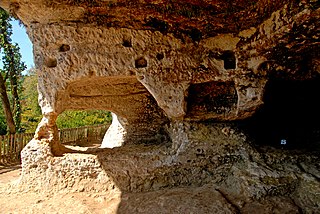
The archaeological site Abri de la Madeleine is a rock shelter under an overhanging cliff situated near Tursac, in the Dordogne département of the Aquitaine région of southwestern France. It represents the type site of the Magdalenian culture of the Upper Paleolithic. The shelter was also occupied during the Middle Ages. The medieval castle of Petit Marsac stands on the top of the cliff just above the shelter.

The Rouffignac cave, in the French commune of Rouffignac-Saint-Cernin-de-Reilhac in the Dordogne département, contains over 250 engravings and cave paintings dating back to the Upper Paleolithic. In conjunction with other caves and abris of the Vézère valley, the Rouffignac cave was classified a Monument historique in 1957 and a World Heritage Site in 1979 by UNESCO as part of the Prehistoric Sites and Decorated Caves of the Vézère Valley.

The Périgord noir, also known as Sarladais, is a traditional natural region of France, which corresponds roughly to the Southeast of the current Dordogne département, now forming the eastern part of the Nouvelle-Aquitaine région. It is centered around the town of Sarlat-la-Canéda.

Laugerie-Basse is an important Upper Paleolithic archaeological site within the territory of the French commune Les Eyzies-de-Tayac-Sireuil in Dordogne. It is known for several works of art from the Magdalenian. In 1979, Laugerie-Basse, along with other nearby paleolithic sites, was inscribed on the UNESCO World Heritage List as Prehistoric Sites and Decorated Caves of the Vézère Valley.

L'Abri Pataud, or the Pataud Shelter in English, is a prehistoric site found in the middle of the village Les Eyzies-de-Tayac-Sireuil in Dordogne, Aquitaine, southwestern France. The site includes human remains, stone tools, and early cultural artifacts made during the Upper Paleolithic, between approximately 47,000 and 17,000 years ago.

The Tito Bustillo Cave is a prehistoric rock shelter located in the small town of Ribadesella, in the autonomous community of Asturias, Spain. The cave was inhabited by humans (cro-magnon) before the year 10,000 BC. Due to the collapse of the rock, the original entrance to the cave was sealed thousands of years ago, which made it possible for preservation of objects, tools and wall paintings that were discovered in 1968. Based on those objects found in the cave, it is known that there was a significant human presence during the Magdalenian culture of the Upper Palaeolithic, but the cave was probably inhabited before that time.

The abri de Cap Blanc is a prehistoric limestone rock shelter with Magdalenian animal sculptures. It is in the Marquay commune on the right bank of the Beune River, a few kilometers west of Eyzies-de-Tayac, in Dordogne.
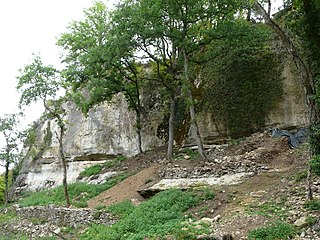
Castel Merle is a complex of 10 prehistoric rock shelters in Sergeac, in the Dordogne region of France. It is close to the Lascaux rock art caves and is situated in the region which forms the Unesco World Heritage site Prehistoric Sites and Decorated Caves of the Vézère Valley, but is not officially a part of it. The finds in the shelters date to the Mousterian and Magdalenian periods, or between 160,000 and 12,000 years ago. The most important of the 10 shelters is the Reverdit rockshelter.

Château Cramirat is a 12th-century Templar castle in the village of Sergeac, Dordogne (Nouvelle-Aquitaine), southwest France. A French national historic monument, the château is situated in the heart of the Vézère river valley, a UNESCO World Heritage Site known as the Valley of Mankind.
